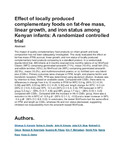Effect of locally produced complementary foods on fat-free mass, linear growth, and iron status among Kenyan infants
Date
2019-05-02Author
Konyole, Silvenus O.
Omollo, Selina A.
Kinyuru, John N.
Skau, Jutta K.H.
Owuor, Bethwell O.
Estambale, Benson B.
Filteau, Suzanne M.
Michaelsen, Kim F.
Friis, Henrik
Roos, Nanna
Owino, Victor O.
Metadata
Show full item recordAbstract
The impact of quality complementary food products on infant growth and body composition has not been adequately investigated. This study evaluated the effect on fat-free mass (FFM) accrual, linear growth, and iron status of locally produced complementary food products comparing to a standard product. In a randomized, double-blind trial, 499 infants at 6 months received nine monthly rations of (a) WinFood Classic (WFC) comprising germinated amaranth (71%), maize (10.4%), small fish (3%), and edible termites (10%); (b) WinFood Lite (WFL) comprising germinated amaranth (82.5%), maize (10.2%), and multimicronutrient premix; or (c) fortified corn–soy blend plus (CSB+). Primary outcomes were changes in FFM, length, and plasma ferritin and transferrin receptors (TfR). FFM was determined using deuterium dilution. Analysis was by intention to treat, based on available cases. Compared with CSB+, there were no differences in change from 6 to 15 months in FFM for WFC 0.0 kg (95% CI [−0.30, 0.29]) and WFL 0.03 kg (95% CI [−0.25, 0.32]) and length change for WFC −0.3 cm (95% CI [−0.9, 0.4]) and WFL −0.3 cm (95% CI [−0.9, 0.3]). TfR increased in WFC group 3.3 mg L−1 (95% CI [1.7, 4.9]) and WFL group 1.7 mg L−1 (95% CI [0.1, 3.4]) compared with CSB+. Compared with the increase in Hb in CSB+ group, there was a reduction in Hb in WFC of −0.9 g dl−1 (95% CI [−1.3, −0.5]) and a lower increase in WFL −0.4 g dl−1 (95% CI [−0.8, 0.0]). In conclusion, the tested WinFoods had the same effect on FFM and length as CSB+, whereas Hb and iron status decreased, suggesting inhibited iron bioavailability from the amaranth-based WinFoods.
URI
https://doi.org/10.1111/mcn.12836https://onlinelibrary.wiley.com/doi/full/10.1111/mcn.12836
http://r-library.mmust.ac.ke/123456789/1591
Collections
- Gold Collection [1026]

